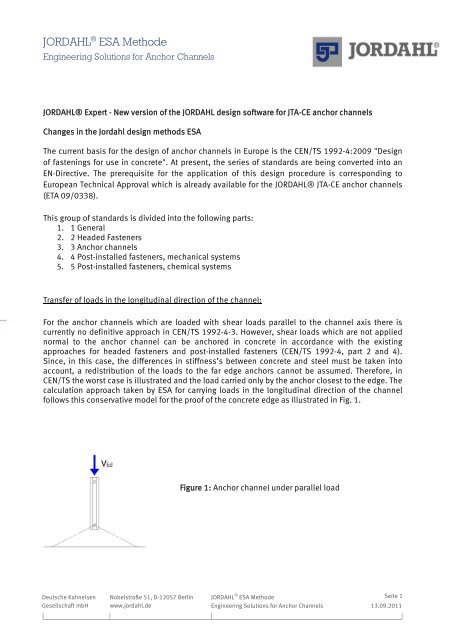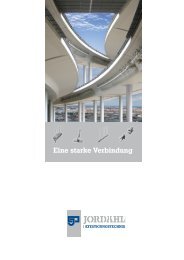Changes in the Jordahl design methods ESA
Changes in the Jordahl design methods ESA
Changes in the Jordahl design methods ESA
You also want an ePaper? Increase the reach of your titles
YUMPU automatically turns print PDFs into web optimized ePapers that Google loves.
JORDAHL ® <strong>ESA</strong> Methode<br />
Eng<strong>in</strong>eer<strong>in</strong>g Solutions for Anchor Channels<br />
JORDAHL® Expert - New version of <strong>the</strong> JORDAHL <strong>design</strong> software for JTA-CE anchor channels<br />
<strong>Changes</strong> <strong>in</strong> <strong>the</strong> <strong>Jordahl</strong> <strong>design</strong> <strong>methods</strong> <strong>ESA</strong><br />
The current basis for <strong>the</strong> <strong>design</strong> of anchor channels <strong>in</strong> Europe is <strong>the</strong> CEN/TS 1992-4:2009 "Design<br />
of fasten<strong>in</strong>gs for use <strong>in</strong> concrete". At present, <strong>the</strong> series of standards are be<strong>in</strong>g converted <strong>in</strong>to an<br />
EN-Directive. The prerequisite for <strong>the</strong> application of this <strong>design</strong> procedure is correspond<strong>in</strong>g to<br />
European Technical Approval which is already available for <strong>the</strong> JORDAHL® JTA-CE anchor channels<br />
(ETA 09/0338).<br />
This group of standards is divided <strong>in</strong>to <strong>the</strong> follow<strong>in</strong>g parts:<br />
1. 1 General<br />
2. 2 Headed Fasteners<br />
3. 3 Anchor channels<br />
4. 4 Post-<strong>in</strong>stalled fasteners, mechanical systems<br />
5. 5 Post-<strong>in</strong>stalled fasteners, chemical systems<br />
Transfer of loads <strong>in</strong> <strong>the</strong> longitud<strong>in</strong>al direction of <strong>the</strong> channel:<br />
For <strong>the</strong> anchor channels which are loaded with shear loads parallel to <strong>the</strong> channel axis <strong>the</strong>re is<br />
currently no def<strong>in</strong>itive approach <strong>in</strong> CEN/TS 1992-4-3. However, shear loads which are not applied<br />
normal to <strong>the</strong> anchor channel can be anchored <strong>in</strong> concrete <strong>in</strong> accordance with <strong>the</strong> exist<strong>in</strong>g<br />
approaches for headed fasteners and post-<strong>in</strong>stalled fasteners (CEN/TS 1992-4, part 2 and 4).<br />
S<strong>in</strong>ce, <strong>in</strong> this case, <strong>the</strong> differences <strong>in</strong> stiffness’s between concrete and steel must be taken <strong>in</strong>to<br />
account, a redistribution of <strong>the</strong> loads to <strong>the</strong> far edge anchors cannot be assumed. Therefore, <strong>in</strong><br />
CEN/TS <strong>the</strong> worst case is illustrated and <strong>the</strong> load carried only by <strong>the</strong> anchor closest to <strong>the</strong> edge. The<br />
calculation approach taken by <strong>ESA</strong> for carry<strong>in</strong>g loads <strong>in</strong> <strong>the</strong> longitud<strong>in</strong>al direction of <strong>the</strong> channel<br />
follows this conservative model for <strong>the</strong> proof of <strong>the</strong> concrete edge as illustrated <strong>in</strong> Fig. 1.<br />
Figure 1: Anchor channel under parallel load<br />
Deutsche Kahneisen<br />
Gesellschaft mbH<br />
Nobelstraße 51, D-12057 Berl<strong>in</strong><br />
www.jordahl.de<br />
JORDAHL ® <strong>ESA</strong> Methode<br />
Eng<strong>in</strong>eer<strong>in</strong>g Solutions for Anchor Channels<br />
Seite 1<br />
13.09.2011
JORDAHL ® <strong>ESA</strong> Methode<br />
Eng<strong>in</strong>eer<strong>in</strong>g Solutions for Anchor Channels<br />
Anchor<strong>in</strong>g <strong>in</strong> lightweight concrete<br />
As <strong>the</strong> load carry<strong>in</strong>g capacity of <strong>the</strong> anchor channels depends essentially upon <strong>the</strong> behaviour of <strong>the</strong><br />
anchor<strong>in</strong>g base, and if <strong>the</strong> anchor<strong>in</strong>g is done <strong>in</strong>to light weight concrete <strong>the</strong> concrete resistances are<br />
adopted accord<strong>in</strong>g to EC 2. The concrete cone resistance is determ<strong>in</strong>ed by <strong>the</strong> E module and <strong>the</strong><br />
tensile strength of <strong>the</strong> concrete. The <strong>ESA</strong> method adjusts <strong>the</strong> resistances depend<strong>in</strong>g upon <strong>the</strong> bulk<br />
density and tak<strong>in</strong>g <strong>in</strong>to account <strong>the</strong> strength of <strong>the</strong> selected lightweight concrete.<br />
Comb<strong>in</strong>ed tension and shear loads<br />
In CEN/TS 1992-4-3 a simplified <strong>in</strong>teraction equation β N α + β V α ≤ 1.0 is specified toge<strong>the</strong>r with <strong>the</strong><br />
use of exponents α = 2.0 for steel failure and α = 1.5 for concrete failure.<br />
Accord<strong>in</strong>g to <strong>the</strong> <strong>design</strong> approach from <strong>ESA</strong>, <strong>the</strong>se comb<strong>in</strong>ations are ma<strong>in</strong>ta<strong>in</strong>ed separately <strong>in</strong><br />
accordance with <strong>the</strong> materials and <strong>the</strong> associated govern<strong>in</strong>g resistances. Therefore, due to <strong>the</strong><br />
different exponents, two <strong>in</strong>teraction functions are obta<strong>in</strong>ed which should be taken <strong>in</strong>to account<br />
dur<strong>in</strong>g <strong>the</strong> verification. This method has already been implemented <strong>in</strong> <strong>the</strong> <strong>in</strong>ternational valid Fibcode<br />
for fasten<strong>in</strong>gs. Us<strong>in</strong>g this more accurate <strong>ESA</strong> approach it is possible <strong>in</strong> many application cases<br />
to achieve higher load<strong>in</strong>gs.<br />
Deutsche Kahneisen<br />
Gesellschaft mbH<br />
Nobelstraße 51, D-12057 Berl<strong>in</strong><br />
www.jordahl.de<br />
JORDAHL ® <strong>ESA</strong> Methode<br />
Eng<strong>in</strong>eer<strong>in</strong>g Solutions for Anchor Channels<br />
Seite 2<br />
13.09.2011
JORDAHL ® <strong>ESA</strong> Methode<br />
Eng<strong>in</strong>eer<strong>in</strong>g Solutions for Anchor Channels<br />
Resistance aga<strong>in</strong>st concrete edge failure by <strong>ESA</strong><br />
In collaboration with <strong>the</strong> University of Dortmund and <strong>the</strong> DIBT <strong>the</strong> anchor channels JTA-CE were<br />
exam<strong>in</strong>ed aga<strong>in</strong>st shear forces <strong>in</strong> concrete. The result<strong>in</strong>g research f<strong>in</strong>d<strong>in</strong>gs allow a significant<br />
<strong>in</strong>crease <strong>in</strong> <strong>the</strong> shear capacity of JORDAHL JTA CE anchor channels both <strong>in</strong> cracked and un-cracked<br />
concrete. The new results of JORDAHL research from DIBT were <strong>in</strong>troduced <strong>in</strong> <strong>the</strong> European<br />
Organisation of Technical Approvals (EOTA), and now are <strong>the</strong> part of European Technical Approval<br />
(ETA).<br />
From <strong>the</strong> JORDAHL-EXPERT version 1.2.1.14 <strong>the</strong> <strong>design</strong> is based on <strong>ESA</strong> method accord<strong>in</strong>g to new<br />
European Technical Approval (ETA).<br />
Deutsche Kahneisen<br />
Gesellschaft mbH<br />
Nobelstraße 51, D-12057 Berl<strong>in</strong><br />
www.jordahl.de<br />
JORDAHL ® <strong>ESA</strong> Methode<br />
Eng<strong>in</strong>eer<strong>in</strong>g Solutions for Anchor Channels<br />
Seite 3<br />
13.09.2011
















